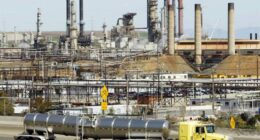
A blustery, angry morning segment of a day-long meeting of the Palm Coast City Council today felt like aftershocks of Hurricane Milton as numerous residents assailed what they saw–against evidence–as the city’s failed response during the storm while some residents praised the same response for weathering a historic rainfall with very limited damage: just five homes had any kind of flooding, the city confirmed this afternoon.
An attempt by City Council member Theresa Pontieri to call for a year-long moratorium on residential construction–this time apparently not limited geographically–was answered with dead silence from her five colleagues. Her motion died for lack of a second.
+
There was no other action. But that segment of the meeting was all pressure valves and gauges as residents exhaled steam and rancor as if pent up during the storm, while the city administration tried–mostly in vain–to show that Palm Coast made it through Milton remarkably unscathed but for minor damage. This morning, county officials said the sum total of damage in Palm Coast was $4.69 million, and just under $19 million countywide.
Earlier the leadership of the city’s stormwater and engineering departments had summed up the system as it is today, and as it performed through Hurricane Milton. The leadership, including Carl Cote and Lynn Stevens, director and deputy director of stormwater and engineering, explained why and how water rose in the city, as designed during extreme rain events, how it drained rather rapidly, and how the city has no control on those areas where the water eventually flows, like the Intracoastal or other surrounding water bodies. If those bodies’ waters or tides rise unusually high, it’s a problem for the city–and a problem with limited solutions.
The explanations did not seem to make much of an impact on residents who addressed the council. The first one to do so called city officials “retarded,” and flipped through pictures of his property: “Here’s where flood or mud was coming into my home, my home, mud, more mud. This is all mud.” He was followed by a resident who lives on a canal and who’s experienced hurricanes in South Florida. ” Palm Coast, the drainage, the culverts, the canals, performed exceptionally well,” he said. A few others echoed his statement.
Several residents complained about flooded street, though not about intrusion into their homes. It came very close for some–but still not into their homes. They spoke in general terms, complaining about what the city was doing with the $18 million budget for stormwater, though Stevens had just flashed pie charts and illustrations on overhead screens. On it went, with residents describing high water again and again–but in yards, in swales, in streets, not mostly in homes. There were exceptions. “My house is flooded now I have to go back to that,” one resident said. Another called for an end to swales.
Residents were addressing the stormwater item, but several called for a “forensic audit” to find out “where you’re spending our money.” They complained of spending on a dog park or a new soccer field. Ohers complained about too much growth. Cornelia Manfre, the candidate for mayor, called it a “failure” that the city had to send out alerts to keep people from using water during the storm. “We own these utilities we should be providing, and these should have been enhanced years ago. This is a failure,” she said. Sandra Shank, a member of the planning board, wondered why “nothing was mentioned” about the city getting a decree from the Department of Environmental Protection to rapidly expand one of its two sewer plants, which gets overwhelmed during storms (that was to be its own item later in the meeting, however, with details, charts and costs.)
Lynn Stevens, the deputy director of stormwater and engineering, presented an overview of what she called the “massive” stormwater system that goes far beyond the 1,222 miles of swales in front of residents’ homes: it also consists of 58 miles of freshwater canals–the backbone of the system–177 miles of ditches, 13 freshwater lakes covering 111 acres, 14 dam-like water-control structures called weirs (they have been equipped with cameras to monitor water levels), and some 5,000 pipe locations and catch basins. It all drains into the Intracoastal and wetlands surrounding the city such as Graham Swamp and Princess Place Preserve, which in turn flow into the Intracoastal.
“That system is also affected by high tides, so oftentimes, the system will back up a bit if the tides are extremely high during a major rainfall event,” Stevens said. She outlined the long list of tasks the department’s 92 employees carry out, regrading swales–just two swale crews do the job–clearing ditches, ensuring that canals flow unimpeded, replacing or maintaining pipes, and so on. Much of that infrastructure is aging.
Stormwater engineering is its own division within the department, managing the city’s stormwater’s $17 million in current capital projects. One of those huge projects is the nearly $10 million London Waterway Expansion project, a large pond in the north end of town to control waters in that end of town.

“During the hurricane situation, we monitor water levels in various locations throughout the city,” Stevens said. “We saw many of those water levels, four to six feet higher in our receiving waters than they were prior to the storm. Again, when that water backs up, it tends to slow down how fast water can get out of our city. We do not control the tides or Mother Nature on the other side of our outfall system. I also wanted to point out that the weekend prior to Hurricane Milton, we were expecting a significant rainfall event due to a northeaster that was coming through our town. Five days prior to that weekend event, staff started adjusting our weir levels and started lowering those weir levels to provide capacity within our city. We brought them down to what we would expect for a hurricane level. And then when we heard about Milton, we started dropping those even further. As a matter of fact, we dropped the weir levels all the way down as far as they would go.”
There was grumbling in the audience, with some people claiming “it didn’t happen.”
“While some of the roadways did experience water over the road, the roads were cleared within 24 hours,” Stevens continued. More grumbling. Homes are built higher than the road–at least 12 inches higher. But the city doesn’t know to what extent grounds around homes sink over time (the homes themselves do not sink). Water pooling in yards flows down to the road which, if the swales are full, acts as part of the stormwater system, driving water to ditches and canals. “We received 14 inches of rain in a very short period of time. Again, we had 4 to 6 feet over normal water levels in many of our areas, although since the ground was so saturated, it is going to take time for yards and swales to recover.”
For all that, Mayor David Alfin said, “My concern is that the stormwater department, as hard as you all are working with all of the updates that you did, there’s a big gap between your your your work, and the community’s expectation.” The question, he said, is how to close that gap over the next year to three years.
Carl Cote, the city’s director of engineering and stormwater, gently pushed back against the mayor’s characterization. “Palm Coast is a master-planned community,” Cote said. “It is a very well designed system compared to a lot of cities in Florida, where the cities are piecemealed. They have much more worse conditions than Palm Coast.” He reiterated the expectation that in unusual rain events, water ends up in the street–not in homes. But to rebuild it all into a curb and gutter system would cost hundreds of millions of dollars, “maybe even a billion,” Cote said. “It’s astronomical. It can’t even be considered to go back and rebuild the city, basically, is what you’re trying to do. But in terms of our stormwater system, we have a very, very good system here in the city. If you look at the flooding around us and all the other communities, we did not experience the extent of flooding that those communities saw during this event. Do we have problems? Yes. Do we have projects lined up to make it better? Yes. And we continue to use that stormwater model to make enhancements and address those concerns.”
Charles Gambaro, the appointed member sitting through his second business meeting, referred to his previous job in the military–as he has frequently done in th short time he’s been on the council–and complained about “fighting the last war” before both curtly rebuffing Cote and mischaracterizing what Cote had said. “I don’t agree that we have the greatest system in the world,” Gambaro told the engineer. Gambaro’s education is heavy on public administration and political science. It’s no engineering. Cote had not described Palm Coast’s system as “the greatest system in the world,” but as “very well designed” compared to a lot of other Florida cities.
It was also unusual for a new council member to so readily and publicly repudiate a director mere days out from a historic storm that evidenced Cote’s point far more than it did Gambaro’s, and after only his first tour of the city. Nor does it help the city administration’s efforts to battle misconceptions and social media’s amplification of misinformation about the stormwater system’s supposed failures. But it could be a hint of the “weapon system” to come, as Gambaro described himself to his colleagues in his first meeting two weeks ago.
Pontieri doesn’t want a band-aid approach. Again, Cote pushed back, citing factors out of the city’s control: Pellicer Creek and the Intracoastal have their own flows of water. The city cannot control those. If those waters rise over time, it’ll impact the city. The city can create additional capacity within its own system. It’s doing that, Cote said. For example, the city is close to improving the flow of water out of the Woodlands, which can flood because of the proximity of Graham Swamp.
The presentation had been designed as just that–an update on the city’s stormwater system. It had been scheduled well before Hurricane Milton was a sand devil over West Africa. But because the presentation was delivered in its immediate aftermath, it became a natural springboard for residents’ frustrations, however soaked in misunderstandings.
“Look, I don’t have solutions to all these problems. Nobody sitting up here has all the solutions,” Council member Ed Danko told the audience. “But I do know that we need to start focusing on the problems that we have here in Palm Coast, Palm Coast 1.0, not Palm Coast 2.0, not a westward expansion. We don’t need a road to nowhere. We need another water treatment plant. We don’t need a sports arena for $93 million. We need another water treatment plant.” He spoke of the ongoing plan to dredge saltwater canals as part of the solution, among other approaches.
It was at that point that Pontieri addressed Danko: “Respectfully, vice mayor, you have contributed to the problem, as has the rest of this board every time they have voted yes on a zoning variance that is increased density,” she said. “I have sat on this board for two years and pounded my fist on two things: lack of water and lack of water capacity. I have said over and over and over, these are issues, guys. We don’t have the ability to provide these services. And if we are saying we have the ability right now, we are perpetuating, I will not say lies, but we are pushing the envelope. And this past week, the envelope got pushed way over the edge.” Pontieri is not opposed to the westward expansion. She cited existing issues on the east side of U.S. 1, cited ongoing improvements and the 10 new hires for stormwater’s employees, then moved again “for another residential building moratorium for one year until we get this under control–we get the storm water under control, we get the wastewater treatment plant under control.” She said the city was in a “hamster wheel,” and needed off.
“A moratorium has huge legal ramifications,” Council member Nick Klufas said, before turning the tables on Pontieri: “Raising our water utility rates to a level that will sustain our utility are necessary, and those steps were not taken by our council.” Pontieri had agreed to raise development impact fees for utility expansion, but not rates, as the administration and its consultant had asked for. Pontieri conceded that with the consent decree looming over the city, not raising rates is no longer an option.
Then Pontieri’s motion died.
![]()
stormwater









